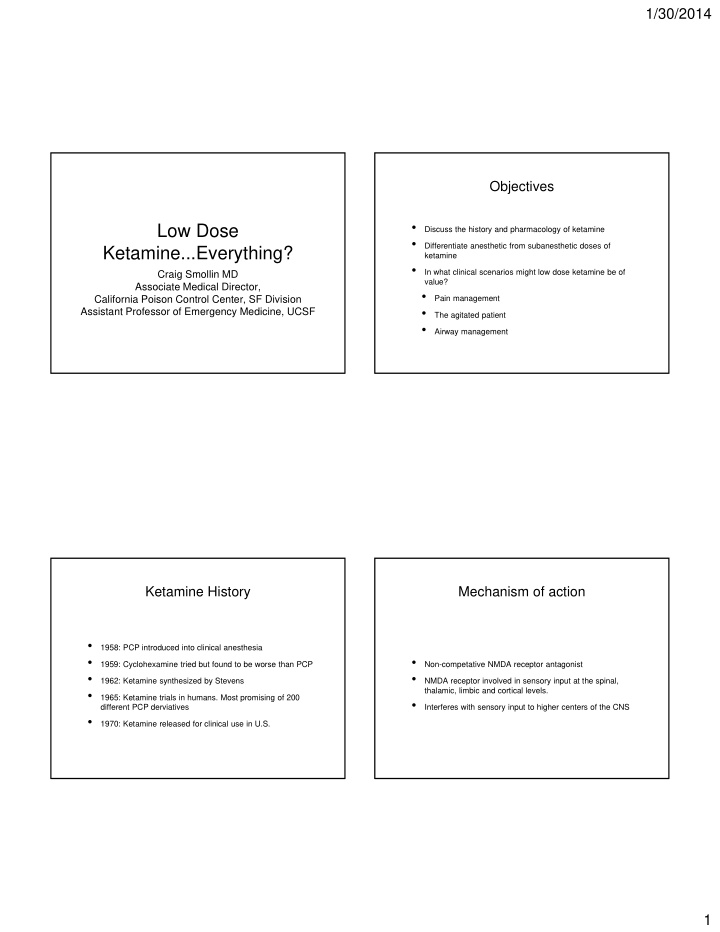



1/30/2014 Objectives • Low Dose Discuss the history and pharmacology of ketamine • Differentiate anesthetic from subanesthetic doses of Ketamine...Everything? ketamine • In what clinical scenarios might low dose ketamine be of Craig Smollin MD value? Associate Medical Director, • California Poison Control Center, SF Division Pain management Assistant Professor of Emergency Medicine, UCSF • The agitated patient • Airway management Ketamine History Mechanism of action • 1958: PCP introduced into clinical anesthesia • • 1959: Cyclohexamine tried but found to be worse than PCP Non-competative NMDA receptor antagonist • • 1962: Ketamine synthesized by Stevens NMDA receptor involved in sensory input at the spinal, thalamic, limbic and cortical levels. • 1965: Ketamine trials in humans. Most promising of 200 • different PCP derviatives Interferes with sensory input to higher centers of the CNS • 1970: Ketamine released for clinical use in U.S. 1
1/30/2014 The role of NMDA receptors Definitions • Anesthetic or dissociative • Sub-dissociative Sedation dosing Low-dose Ketamine Time to peak Duration of Route Dose Onset effect action Intravenous 0.5-1.0 mg/kg < 1 min 3-5 min 5-10 min • Defined as the administration of 0.1 to 0.6 mg/kg IV Intramuscular 2-4 mg/kg 2-5 min 20 min 30 min Nasal 5 mg/kg 10 min 20 min 1 hour Can also be administered via oral and rectal routes, however with signficantly greater time to onset and duration of action. 2
1/30/2014 Clinical Scenarios Clinical Scenario #1 • We will discuss the following clinical scenarios: • • A 35 year old male with h/o IV heroin abuse presents with a A patient with a history of IVDU and high opiate tolerance left deltoid abscess. Exam sig for a 10 x 7 cm area of with a large deltoid abscess requiring incision and erythema, swelling, and fluctulence over the left lateral drainage. deltoid. The patient complains of 10/10 pain and will barely • A child with a long bone fracture of the extremity. allow you to touch his arm. He is given a total of 4 mg of dilaudid without improvement in pain. How would you • A 35 year old male with extreme agitation requiring continue management of this patient given the need for an aeromedical transport to another facility incision and drainage? • A patient in respiratory distress on BIPAP Opiate sparing effects Opiate sparing effects • • Management of severe acute pain in emergency settings: Peri-operative ketamine for acute post-operative pain: a ketamine reduces morphine consumption. Am J. Emerg quantitative and qualitative systematic review (Cochrane Med 2007; 25:385-90 review) Acta Anaesthesiol Scand 2005;49:1405-142 • • IV morphine injection of 0.1 mg/kg, followed by 3 mg 27/37 trials found that peri-operative ketamine every 5 hours reduced rescue analgesic requirements or pain • intensity, or both. Placebo (saline) or ketamine 0.2 mg/kg over 10 minutes • • In the first 24 h after surgery, ketamine reduces Ketamine group required much less morphine to achieve morphine requirements. same pain scale scores (<30/100) 3
1/30/2014 Ketamine and agitation Ketamine and agitation • Initial ketamine dosing range given was 0.5 - 1 mg/kg. • If two doses required within first 60 min of initiation of sedation infusion started at initial rate of 1 - 1.5 mg/kg per hour. • The amount given was titrated to achieve a target sedation level that was a calm, cooperative patient who could still respond to verbal commands.” 4
Recommend
More recommend